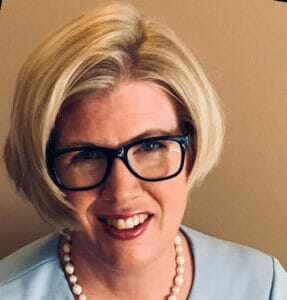
Marketing Darwinism: Gayle, you left a brilliant sales career at stalwarts like Informa and Microsoft to start your own gig. Is this part of the “Great Resignation” or is something else afoot?
Gayle Keller: I have always been a woman who has reinvented her professional life. It just so happens I pressed pause on my corporate career and left a role (and company) that I admire during The Great Resignation in search of more balance and fulfillment in this season of life.
I spring boarded from sales into the entrepreneurial abyss to reinvent myself while embracing the uncomfortable feeling of the unknown.
- Was I nervous?
- Was I apprehensive?
- Was I afraid of failing?
Absolutely YES to all three questions! However, I knew I had to let my calling be stronger than my fear to guide me on my new path.
Marketing Darwinism: You emphasize re-invention and also the gendered aspects of work. How are they connected?
Gayle Keller: With respect to reinvention and gender inclusivity, unconscious bias still exists which influences our behaviors and ultimately can impede inclusion. Corporate inclusion is acknowledging differences and collectively bringing them together for a common mission – to drive project success, build camaraderie, and recognize and acknowledge those who contribute to the company’s bottom line. Diversity, equity, and inclusion are even more important in our globalized world today. To be a diverse organization, you must have a focus on inclusion; it’s no longer an option.
Marketing Darwinism: You once told me you were a marketer at heart and I recall you once led a marketing conference. Can you describe how you have brought your “marketing bent” to bear on both our sales and your entrepreneurial endeavors.
Gayle Keller: We are all marketers and sellers at heart, no matter what profession we choose. As consumers, we buy from brands that speak to us. As businesspeople, we buy and/or partner with people and organizations who we can related to and that will support us in exceeding our goals.
Marketing is a form of communication and a way to connect with others. Communication skills (and good manners!) are critical in relationship building. To that point, your personal brand is everything and is a vital part of standing out in this world, especially if you are looking to reinvent your professional life.
Marketing Darwinism: What lessons for a young marketer would you have? What would you suggest they emphasize in their learning?
Gayle Keller: My advice is to network and start as early as possible. Starting to network when you’re in college is a key element to bridging the gap from campus life to professional life. The sooner you start to network, the sooner the universe acknowledges your hopes, dreams, and begins to align people and potential opportunities your way.
Networking at the organizations you desire to work at as well as people (both inside and outside of your industry) whom you admire can strengthen your confidence and give you the clarity you need to follow your aspirations. The art of networking is truly magical.
Marketing Darwinism: Describe the services you offer to companies and how it helps them become better environments for success?
Gayle Keller: The corporate ladder has a broken rung when it comes to inclusion, and I address revitalizing gender inclusivity head on with my advisory work and five pillar methodologies. For example, if a company has a strong culture with happy employees, that company thrives, and chances are so does their profitability. A positive culture improves performance and outcomes while decreasing employee onboarding and turnover costs and efforts which, in turn, increases employee retention.
Furthermore, gender inclusivity fosters accelerated productivity in a collaborative environment, and results in all genders feeling respected, supported, and appreciated.
Marketing Darwinism: Who are some of your marketing mentors? Do you recommend mentorship to all people, irrespective of age or experience?
Gayle Keller: I have been blessed by having a few marketing mentors throughout my many seasons of life – Romi Mahajan has been one of my personal mentors for nearly 10 years.
Yes, I absolutely recommend mentorship to all people regardless of age or experience. Career reinvention and professional risk-taking have no age limitations. Having a trifecta of mentors, business coaches, and sponsors in your professional arena is a secret sauce to success, growth, and satisfaction. You can never go wrong with investing in yourself for it will set you apart from your competition. And a good rule of thumb is to pay it forward by contributing to the success of others.
Marketing Darwinism: What are your predictions for business in 2022? What are 3 or 4 trends you see as important?
Gayle Keller: My predicted top business trends for 2022 are:
- The Great Resignation
- Flexibility and Autonomy
- Career Reinvention
The biggest trend defining the way we do business is The Great Resignation and mitigating employee turnover. As a culture, we have craved the ability to navigate the intersection between work/life integration with a pinch of flexibility and a handful of autonomy. With The Great Resignation underway, I don’t see the movement as a negative but more of a positive. It’s an opportunity for companies to do a better job reaching gender parity, shine a spotlight on mental health and wellness while being more empathetic towards their employees.
The Great Resignation provides an opportunity for employees to have more flexibility and autonomy to work on their own terms with their role given the hybrid work model and the ability to work from anywhere. It also provides an opportunity for employees to seek career reinvention to find work/life integration and do something that makes their heartstrings sing.
Career Reinvention is something we all should embrace, regardless of gender. Reinvention occurs when you get a promotion, make a lateral move into another division/department, or leave a company altogether. We are constantly reinventing ourselves and given we’re living in a global hybrid work environment; it is more important than ever to make sure you are continuing your learnings through trainings and courses while networking with people both inside and outside your company.
*****
Gayle’s Bio: As a professional speaker, advisor, coach, podcast host, author and former award-winning executive leader who has a deep passion for improving communications and relationships, Gayle Keller, Chief Reinvention Officer, leads, facilitates, inspires, and revitalizes gender inclusivity programs for select corporations and universities. Learn more about Gayle here https://gaylekeller.org/














